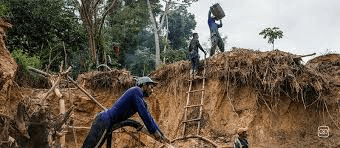The Threat of Illegal Mining from Brazil Crossing the Border and Reaching Suriname

dr. Edivando Vitor do Couto / eyesonsuriname
Amsterdam June 3d 2024–Illegal mining, particularly gold mining, is a significant issue in Brazil, especially within the Amazon region. The problem has been exacerbated by the involvement of organized crime groups such as the First Command of the Capital (PCC) and the Red Command (CV), which provide miners with machinery, security, and logistics, facilitating operations that often cross national borders into neighboring countries like Suriname ( Dialogo Americas ).

Impact on Suriname’s Economy
- Economic Disruption:
- Loss of Revenue: Illegal mining circumvents formal economic channels, leading to significant tax revenue losses for the government. This undermines Suriname’s economic stability and development efforts ( Mongabay, Dialogo Americas ).
- Increased Costs: The government incurs additional expenses in combating illegal activities and addressing the resultant environmental and health crises.
- Market Instability:
- Gold Market Distortion: Suriname’s gold market can become distorted due to the influx of illegally mined gold. This affects legal mining operations by depressing gold prices and creating an uneven playing field for lawful businesses ( Mongabay ).
- Investment Deterrent:
- Investor Confidence: Persistent illegal activities can deter potential foreign and local investors due to perceived instability and lack of regulatory enforcement ( Dialogo Americas ).
Impact on Suriname’s Biodiversity
- Environmental Degradation:
- Deforestation: Illegal mining often involves clearing large areas of rainforest, contributing to significant deforestation. This loss of forest cover impacts biodiversity, climate regulation, and carbon sequestration capabilities (Global Issues) (Mongabay).
- Water Contamination: The use of mercury in gold extraction contaminates rivers and streams, leading to long-term ecological damage and health hazards for aquatic life and communities relying on these water sources (Global Issues) (Diálogo Américas).
- Biodiversity Loss:
- Habitat Destruction: The destruction of habitats due to mining activities leads to the loss of flora and fauna, some of which may be endemic or endangered. This biodiversity loss reduces the ecological resilience of the region ( Mongabay )
- Disruption of Ecosystem Services: The alteration of natural landscapes disrupts ecosystem services such as pollination, water purification, and soil fertility, which are crucial for maintaining ecological balance and supporting human livelihoods ( Global Issues ).
- Impact on Indigenous Communities:
- Health and Livelihoods: Indigenous communities in Suriname, similar to those in Brazil, face health crises due to mercury exposure and the destruction of their traditional lands. This undermines their traditional way of life and cultural heritage ( Global Issues, Dialogo Americas ).
Proposal: Platform for Monitoring Illegal Mining on the Brazil-Suriname Border
The proposed platform aims to monitor and combat illegal mining activities along the Brazil-Suriname border using advanced technologies including satellite imagery, artificial intelligence (AI), geoprocessing, and machine learning. This platform will generate real-time location maps and alerts, similar to the MapBiomas Alert system, to enable swift and effective responses from authorities and stakeholders.

Objectives
- Real-Time Monitoring: Provide continuous surveillance of the border area using satellite imagery.
- Automated Detection: Utilize AI and machine learning to detect and classify illegal mining activities.
- Geospatial Analysis: Employ geoprocessing techniques to create detailed maps highlighting areas of concern.
- Alert System: Develop an automated alert system to notify authorities of detected illegal activities.
- Data Integration: Integrate data from multiple sources for comprehensive analysis and reporting.
Components of the Platform
Satellite Imagery:
- Data Sources: Use high-resolution satellite imagery from providers such as NASA, ESA (European Space Agency), and commercial providers like DigitalGlobe.
- Frequency: Implement frequent satellite passes to ensure up-to-date monitoring.
Artificial Intelligence and Machine Learning
dr. Edivando Vitor do Couto / eyesonsuriname









